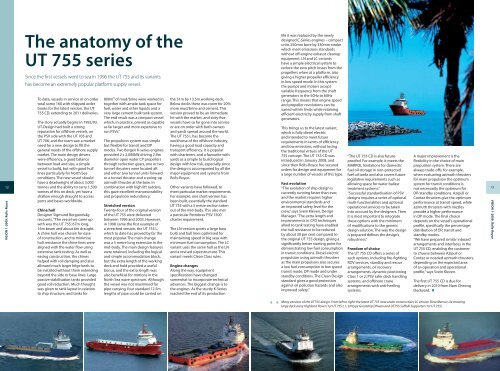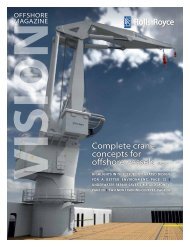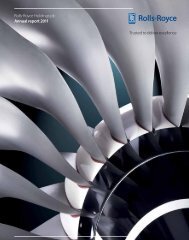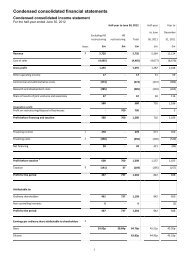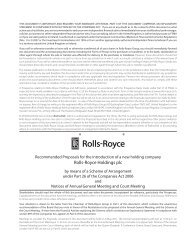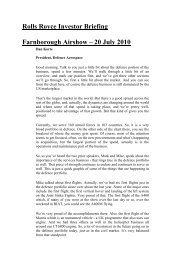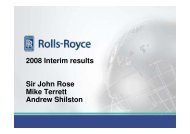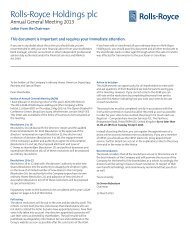Vision 2009 - Rolls-Royce
Vision 2009 - Rolls-Royce
Vision 2009 - Rolls-Royce
Create successful ePaper yourself
Turn your PDF publications into a flip-book with our unique Google optimized e-Paper software.
12<br />
VISION 1-<strong>2009</strong>. <strong>Rolls</strong>-<strong>Royce</strong><br />
The anatomy of the<br />
UT 755 series<br />
Since the first vessels went to sea in 1996 the UT 755 and its variants<br />
has become an extremely popular platform supply vessel.<br />
To date, vessels in service or on order<br />
total some 160 with shipyard order<br />
books for the latest version, the UT<br />
755 CD, extending to 2011 deliveries.<br />
The story actually begins in 1992/93.<br />
UT-Design had built a strong<br />
reputation for offshore vessels, on<br />
the PSV side with the UT 705 and<br />
UT 706, and the team saw a market<br />
need for a new design to fill the<br />
general needs of the offshore supply<br />
market. The main design drivers<br />
were efficiency, a good balance<br />
between load and size, a simple<br />
vessel to build, but with good hull<br />
lines particularly for North Sea<br />
conditions. The new vessel should<br />
have a deadweight of about 3,000<br />
tonnes and the ability to carry 1,500<br />
tonnes of this on deck, yet have a<br />
shallow enough draught to access<br />
ports and bases worldwide.<br />
Chine hull<br />
Designer Sigmund Borgundvåg<br />
recounts, “The vessel we came up<br />
with was the UT 755; 67m long,<br />
16m beam and about 6m draught.<br />
A chine hull was chosen for ease<br />
of construction, and to minimise<br />
hull resistance the chine lines were<br />
aligned with the water flow using<br />
extensive tank testing. As well as<br />
easing construction, the chines<br />
helped with roll damping and also<br />
allowed much larger bilge keels to<br />
be installed without them extending<br />
beyond the side or base lines. Large<br />
passive stabilisation tanks provided<br />
good roll reduction. Much thought<br />
was given to tank layout in relation<br />
to ship structure, and tanks for<br />
800m³ of mud/brine were worked in,<br />
together with ample tank space for<br />
fuel, water and other liquids and a<br />
very large cement bulk tank system.<br />
The end result was a compact vessel<br />
which, in practice, proved as capable<br />
as far larger and more expensive to<br />
run PSVs.”<br />
The propulsion system was simple<br />
but flexible for transit and DP<br />
modes. Two Bergen K-series engines<br />
provided 2 x 2,000kW driving 2.9m<br />
diameter open water CP propellers<br />
through reduction gears, one or two<br />
tunnel thrusters were located aft<br />
and either two tunnel units forward<br />
or a tunnel thruster and a swing-up<br />
azimuth thruster at the bow. In<br />
combination with high lift rudders,<br />
this gave excellent manoeuvrability<br />
and propulsion redundancy.<br />
Stretched version<br />
Twenty-four of the original version<br />
of the UT 755 were delivered<br />
between 1996 and 2003. However,<br />
in 1998 came the first example of<br />
a stretched version, the UT 755 L,<br />
which to date has proved by far the<br />
most popular. The main change<br />
was a 5 metre long extension in the<br />
mid-body. The main design features<br />
were retained, including the logical<br />
and simple accommodation block,<br />
but the extra length of the working<br />
deck and hold provided a useful<br />
bonus, and the extra length was<br />
also beneficial for motions in the<br />
North Sea wave spectrum. Although<br />
the vessel was not maximised for<br />
pipe carrying, four standard 12.5m<br />
lengths of pipe could be carried on<br />
the 51m by 13.5m working deck.<br />
Below decks there was room for 20%<br />
more mud/brine and cement. This<br />
version proved to be an immediate<br />
hit with the market, and sixty-five<br />
vessels have so far gone into service<br />
or are on order with both owners<br />
and yards spread around the world.<br />
The UT 755 L has become the<br />
workhorse of the offshore industry,<br />
having a good load capacity and<br />
transport efficiency. It is popular<br />
with charterers, and a favourite with<br />
yards as a simple to build logical<br />
design with low risk, especially since<br />
the design is accompanied by all the<br />
major equipment and systems from<br />
<strong>Rolls</strong>-<strong>Royce</strong>.<br />
Other variants have followed, to<br />
meet particular market require ments.<br />
For example, one short version has<br />
been built, essentially the standard<br />
UT 755 with a 5 metre section taken<br />
out of the mid-body. This also met<br />
a particular Petrobras ‘PSV 1500’<br />
charter requirement.<br />
The LN-version sports a large bow<br />
bulb and hull lines optimised for<br />
maintaining speed in big seas with<br />
minimum fuel consumption. The LC<br />
variant uses the same hull as the LN<br />
and a revised superstructure. This<br />
variant meets Clean Class rules.<br />
Engine changes<br />
Along the way, equipment<br />
specifications have changed<br />
somewhat to incorporate technical<br />
advances. The biggest change is to<br />
the engines. As the sturdy K-Series<br />
reached the end of its production<br />
life it was replaced by the newly<br />
designed C-Series engines – compact<br />
units 250mm bore by 330mm stroke<br />
which meet emissions standards<br />
without off-engine exhaust cleanup<br />
equipment. LN and LC variants<br />
have a simple electrical system to<br />
reduce the zero pitch losses from the<br />
propellers when at a platform, also<br />
giving a higher propeller efficiency<br />
in low speed mode. In this system<br />
the pumps and motors accept<br />
variable frequency from the shaft<br />
generators in the 50Hz to 60Hz<br />
range. This means that engine speed<br />
and propeller revolutions can be<br />
varied within limits while retaining<br />
efficient electricity supply from shaft<br />
generators.<br />
This brings us to the latest variant,<br />
which is fully diesel electric<br />
and intended to meet future<br />
requirements in terms of efficiency<br />
and low emissions, without losing<br />
the traditional virtues of the UT<br />
755 concept. The UT 755 CD was<br />
introduced in January 2008, and<br />
since then <strong>Rolls</strong>-<strong>Royce</strong> has secured<br />
orders for design and equipment for<br />
a large number of vessels of this type.<br />
Fast evolution<br />
“The evolution of ship design is<br />
currently running faster than ever,<br />
and the market requires higher<br />
environmental standards and<br />
an improved safety level for the<br />
crew,” says Svein Kleven, Design<br />
Manager. “The extra length and<br />
improvements in CFD techniques<br />
allied to tank testing have enabled<br />
the hull resistance to be reduced<br />
by about 30 per cent compared to<br />
the original UT 755 design, giving a<br />
significantly better starting point for<br />
demonstrating low fuel consumption<br />
in transit conditions. Diesel electric<br />
propulsion using azimuth thrusters<br />
as the main propulsors also secures<br />
a low fuel consumption in low speed<br />
transit mode, DP mode and under<br />
standby conditions. The Clean Design<br />
standard gives a good protection<br />
against oil pollution hazards and also<br />
improved safety.”<br />
“The UT 755 CD is also futureproofed.<br />
For example, it meets the<br />
MARPOL limitations for domestic<br />
fuel oil storage in non-protected<br />
fuel oil tanks and also covers future<br />
legislative requirements such as<br />
allowing space for water ballast<br />
treatment systems.”<br />
“Successful standardisation of PSV<br />
designs requires a series of optional<br />
multi-functionalities and optional<br />
operational services to be taken<br />
into account by the designers. Then<br />
it is most important to integrate<br />
these options with the minimum<br />
of modifications to the generic<br />
design solution. The way the design<br />
is prepared defines the design’s<br />
robustness.”<br />
Freedom of choice<br />
The UT 755 CD offers a series of<br />
such options, including fire-fighting,<br />
ROV services, standby and rescue<br />
arrangements, oil recovery<br />
arrangements, dynamic positioning<br />
Class 1 or 2, PSV safer deck handling<br />
systems, and offshore crane<br />
arrangements with anti-heeling<br />
systems.<br />
A major improvement is the<br />
flexibility in the choice of main<br />
propulsion system. There are<br />
always trade-offs: for example,<br />
when evaluating azimuth thrusters<br />
for main propulsion the optimum<br />
system for transit conditions is<br />
not necessarily the optimum for<br />
DP/standby conditions. Azipull or<br />
Contaz thrusters give the optimum<br />
performance at transit speed, while<br />
azimuth thrusters with nozzles<br />
provide a higher performance<br />
in DP mode. The final choice<br />
depends on the vessel’s operational<br />
profile, specifically the percentage<br />
distribution of DP, transit and<br />
standby modes.<br />
“We have prepared similar inboard<br />
arrangements and interfaces in the<br />
UT 755 CD, enabling the customer<br />
to choose between Azipull or<br />
Contaz or nozzled azimuth thrusters,<br />
depending on the expected area<br />
of an operation and operational<br />
profile,” says Svein Kleven.<br />
The first UT 755 CD is due for<br />
delivery in 2010 from Nam Cheong<br />
Dockyard. A<br />
13<br />
VISION 1-<strong>2009</strong>. <strong>Rolls</strong>-<strong>Royce</strong><br />
B B<br />
Many versions of the UT755 design. From left to right: the latest UT 755 now under construction; LC version Dina Mercur; LN showing<br />
large deck area; Highland Rover (1st UT 755 L ) ; LN type Greatship Dhwan and UT755 Suffolk Supporter (1st UT 755).


